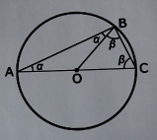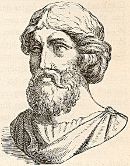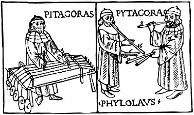Pre-socratic Philosophy · 4143 dagen geleden by Ad van den Ende
´Euclidian geometry and Greek philosophy still influence our thinking. Greek mathematicians and philosophers were real scientists. But their science differs from Newtonian science in the absence of physical principles that enable one to predict future events from current observations. They were unable to correlate apparently disperate phenomena in the universe. They did understand neither the periodicity of the tides nor the behavior of freely falling bodies.
Still we owe much to the ancient Greeks for their observational astronomy, their philosophy and their mathematics. The Greeks were great experts in geometry, and the laws of motion of bodies can be only expressed in a geometrical context. Thanks to geometry we can formulate physical laws that enable us to correlate disparate spatial events.
(Lloyd Motz)
History
Western philosophy began in ancient Greece in the 6th century BCE. The Presocratics were mostly from the eastern or western fringes of the Greek world. Their efforts were directed to the investigation of the ultimate basis and essential nature of the external world.4 They sought the material principle (archê) of things, and the method of their origin and disappearance. As the first philosophers, they emphasized the rational unity of things, and rejected mythological explanations of the world. Only fragments of the original writings of the presocratics survive. The knowledge we have of them derives from accounts of later philosophical writers.
Milesian school
Thales of Miletus (ca 624 – 545 B.C.)
‘Western philosophy begins with Thales’, meaned Bertrand Russell, and Aristotle did call him one of the Seven Sages of Greece.
Thales was born in Miletus, an ancient Greek Ionian city on the eastern coast of the Aegean Sea. He rejected mythological explanations of the existence or the World. Other philosophers did follow him, and did bring about the first scientific revolution.
Thales was the first to define general principles and set forth hypotheses.
The Greek historian Herodotus writes that Thales once predicted a solar eclipse, which happened probably on May 28, 585 B.C.
Probably Thales came from a wealthy family. He made a grand tour in Egypt. He had instruction from Egyptian priests, we are told.
He understood similar triangles and right triangles, and used that knowledge in measuring the height of the pyramids. He measured the height of their shadows at the moment when his own shadow was equal to his length. His body and shadow formed a right triangle, with two equal legs. All right triangles with equal legs are similar. So the length of the piramid’s shadow, measured from its center at that moment, must be equal to its height.
Propositions.
1. In isosceles triangles the angles at the base are equal.
2. ‘The angle in a semicircle is a right angle’.
OA = OB, so the angles α are equal. OB = OC, so the angles β ara equal too. Three angles of a triangle are together 180°, so
α + (α + β) + β = 180° so α + β = 90°
Aristotle described Thales as the founder of natural philosophy. He recorded: ‘Thales says that it is water’. ‘it’ is the nature, the originating principle of the whole world. For Thales, this nature was a single material substance, water. “Thales”, says Cicero, “assures that water is the principle of all things; and that God is that Mind which shaped and created all things from water.” Water can readily be observed in the three states of liquid, vapour and ice. The understanding that water could generate into earth is basic to Thales’s watery thesis.
In De Caelo Aristotle wrote: ‘This [opinion that the earth rests on water] is the most ancient explanation which has come down to us, and is attributed to Thales of Miletus.’
This floating on water caused earthquakes, said Thales. The earth is fluctuating sometimes because of the roughness of the oceans.
Thales’s hypothesis is an advance upon the traditional Homeric view that earthquakes resulted from an angry supernatural god, Poseidon, shaking the earth through his rapid striding.
Thales did propose explanations of natural phenomena which were materialistic rather than mythological or theological. He was the first person about whom we know he did so.
Next came Anaximander (610-546 BCE), the first writer on philosophy. He assumed as the first principle an undefined, unlimited substance without qualities, out of which the primary opposites, hot and cold, moist and dry, became differentiated.
His younger contemporary, Anaximenes (585-525 BCE), took for his principle air, conceiving it as modified, by thickening and thinning, into fire, wind, clouds, water, and earth.
Ephesian school
Heraclitus of Ephesus on the western coast of Anatolia in modern Turkey (535-475 BCE) posited that all things in nature are in a state of perpetual flux held together by a dynamic, eternal structure or pattern, which he termed the Logos. Metaphorically, Heraclitus had used the image of fire to represent this eternal pattern. From fire all things originate, and return to it again in a process of development.
Summary of volume I, § 1 to §13 of The Mechanization of the World Picture, written by E.J.Dijkstehuis
I. Introduction
1. The mechanical or mechanistic conception of the world led to the methods of research and treatment which have caused the great flourishing of physical science: – experiment as the source of knowledge; – mathematical formulation as the descriptive medium; – mathematical deduction as the guiding principle in the search for new phenomina, to be verified by experimentation.
The succes of this conception made the development of modern technology possible. The modes of thought, inherent in this conception, penetrated into philosophical thought about man and his place in the universe.
2. The distinction is made between ancient, classical and modern science:
ancient physical science begins with Thales of Miletus (about 600 B.C.). Classical physical science dates from the appearance of Newton´s Principia in 1687. Modern physical science begins in 1900, when Max Planck framed the quantum concept.
Classical physical science gradually evolved from ancient science and (…) did not need to repudiate or ignore several of the results obtained in the preceding period, but could adopt them after suitable transformation, carrying on the work along the lines already broadly sketched by the ancients.
Greek antiquity (…) is the true nursery of European culture.
3. The intellectual legacy of ancient Greece has two aspects: the great fundamental ideas of a philosophical rather than a scientific nature, and the positive results of the Greek sciences.
II. Main Currents of Greek philosophical thought about nature
A. Pythagoreanism
4. Pythagoras provided strong support for the conception of the cosmos as an orderly and beautiful structure of the physical universe. As Aristotle formulated this: the whole of the heavens is harmony and number.
The motions of the heavenly bodies can be defined by numerical proportions. The harmony of the spheres don’t need to be audible: the mind’s ear takes the place held by the ear in music.
5. The Pythagoreans accorded supremacy to natural numbers and their proportions.
They observed the consonant musical intervals of the octave, the fifth and the fourth by the proportions 2 : 1, 3 : 2 and 4 : 3.
Aristotle did sum up the whole of the Pythagorean doctrine in the paradox: all things are numbers.
The Pythagoreanism established a close connection between physical science and mathematics. This connexion was to become one of the two pillars of classical science. But it played only a minor part in promoting the insight into the importance of conscious empirical research, the other pillar.
In the Pythagorean school flourished rationalism and mysticism. The school did show a religious-ethical character.
Pure knowledge, in which the imperfections of the world of the senses are shaken off or idealized into perfections, contains an element of escapism and ascetism; being directed at immaterial things, it amounts to a ‘katharsis’ (purification) of the soul, an emancipation from the bonds of the senses.
Modern laboratory (compared with the lab of Pythagoras!)
B. Eleaticism
6. Parmenides believed that the changes we observe in the world are mere illusions, due to the deception of our senses.
True being lacks all those properties we are so ready (…) to attribute to things(…). It has not become, does not change, and does not decay; it is one and indivisible.
The Eleatic belief in the immutability of being exerted a strong influence on Greek thought.
C. The Greek corpuscular theories
7. Greek thought in general seems to have been attracted by the idea that all observed change is based on something permanent. To preserve the immutability of being they did give up unity, either in the qualitative (Empedocles) or in the quantitative (Democritus) sense.
Empedocles established the doctrine of the four elements. All substances are conceived to be composed of four qualitative different primary elements: earth, water, air and fire. This does not imply that the elements are to be found in these substances in their pure form. Empedocles probably assumed that these four elements occur as imperceptible particles. Changes consist in the combination, the separation and the motions of these particles under the influence of the forces ‘Love’ and ‘Hate’. This is the first example of what may be called a corpuscular theory of matter.
8. Leucippus and Democritus framed an atomic theory: they did break up the sphere of being of Parmenides into small particles, and they scattered these fragments of being in what the Eleatics had colled not-being: the void.
The fragments differ from each other solely in shape and in size. They are unchanging. All changes are reduced to motions of these corpuscles. The qualitative differences are attributed to differences in size, shape, position, arrangement and state of motion of the atoms.
From all eternity the atoms are in motion in the infinite void. The atoms formed whirling constellations, which expanded into worlds. In due time these worlds will dissolve again into their constituent parts.
9. The guiding principle of the Greek atomists was: the movement of bodies which, while we are watching them, don´t change perceptibly, is a phenomenon of daily observation, and we perceive that this causes certain changes in our environment; the cause of other changes (…) is not visible; it is natural to satisfy the craving for a causal explanation by assuming that in a microscopic world movements of imperceptible, immutable corpuscles take place, which constitute this cause. The idea may be called primitive, but it was destined to meet with unparalleled success in physical science, and therefore it probably expresses an essential property of material things.
10. The atomic theory did give a plausible explanation of several physical phenomena: a substance has greater density if there are fewer ‘vacua’ between the atoms; it could account for differences in hardness and divisibility, and changes of physical state. But it could not answer the question why the atoms form bodies, and it failed to account for the ‘secondary´ qualities: colour, taste, smell, sound, heat, cold and so on.
The perception of these qualities depends on the state of the perciever. That´s why their objective reality was denied.
11. The human soul (his vital principle) and the gods did consist of atoms too. Everything is subject to blind chance. This materialism led to an atheistic world view. (…) this consequece greatly affected the fortune of his system, and accordingly the historical development of science.
12. The particles affect one another through the action upon coming into contact. Forces which act across a distance are excluded.
13b. The atoms fall through the void in a given direction. The larger ones fall faster than the smaller ones; the former will collide with the latter, and form vortices, which in turn generate worlds.
13. The Greek philosopher Epicurus used atomism as the scientific basis of his ethical system, with the result that it shared in the fierce opposition raised to the latter, especially by the Stoics and the Christians.
The Roman poet Titus Lucretius Carus made it the subject of his famous poem ´De rerum natura´. This did save the atomic theory from oblivion.





